ExoMars Trace Gas Orbiter Instruments
Investigating the Martian atmosphere
The ExoMars Trace Gas Orbiter is an ESA and Roscosmos mission to Mars. It is investigating trace gases – gases which are present in small concentrations in the atmosphere, making up less than 1 per cent of it. There is particular focus on hydrocarbons or sulphur species which could be signatures of active biological or geological processes, at present or in the past.
The Trace Gas Orbiter carries scientific instruments for the detection of trace gases with an improved accuracy - 1000 times better - compared to previous measurements from orbit and ground-based measurements. It is also providing new data for the study of the temporal and spatial evolution of trace gases in the Martian atmosphere, and for the location of their source regions.
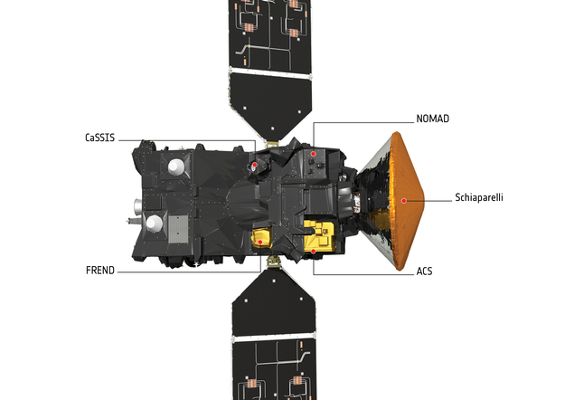 |
| Artist's impression of the Trace Gas Orbiter showing where the science instruments are located. Credit: ESA/ATG medialab |
Science objectives
The Orbiter is used to investigate trace gases with the following scientific objectives:
Deliver a detailed characterisation of the Martian atmosphere's composition.
This includes mapping the distribution of trace gases, identifying their sources and sinks, and studying geographical and temporal variability.
The first scientific goal will be to detect a broad suite of atmospheric trace gases, and key isotopologues (molecules that have at least one atom with a different number of neutrons than the parent molecules), to establish the atmospheric inventory.
Following a positive detection of key species, geographical (location and altitude) and seasonal mapping will be carried out. Mapping of the deuterium/hydrogen ratio (D/H) will also be performed, to provide new information on water reservoirs and atmospheric escape.
A third goal is characterising the state of the atmosphere, in particular temperatures, aerosols, water vapour, and ozone. The data assimilation technique adopted by the science team will allow them to model the atmospheric circulation. This will help determine whether particular gases are emanating from specific areas on Mars and to provide insights into the nature of the trace gas source.
Imaging of surface features
Another important objective is to image and to characterise features on the Martian surface which may be related to trace gas sources. The data should provide information on the geological and dynamical context (such as volcanism) for any sources detected.
Mapping of subsurface hydrogen
The final objective is to map the subsurface hydrogen to a depth of one metre, with a resolution ten times better than previous measurements.
Instruments in brief
The Trace Gas Orbiter, manufactured in Europe, carries a science payload of four instruments:
| NOMAD – Nadir and Occultation for MArs Discovery |
| NOMAD combines three spectrometers, two infrared and one ultraviolet, to perform high-sensitivity orbital identification of atmospheric components, including methane and many other species, via both solar occultation and direct reflected-light nadir observations. |
| Principal Investigator: Ann Carine Vandaele, Belgian Institute for Space Aeronomy, Belgium Co-Principal Investigator: José Lopez Moreno, Instituto de Astrofísica de Andalucía, Spain Co-Principal Investigator: Giancarlo Bellucci, Istituto Nazionale di Astrofisica, Italy Co-Principal Investigator: Manish Patel, The Open University, United Kingdom Participating countries: Belgium, Spain, Italy, United Kingdom, United States of America, Canada. |
| ACS– Atmospheric Chemistry Suite |
| This suite of three infrared instruments will help scientists to investigate the chemistry and structure of the Martian atmosphere. ACS complements NOMAD by extending the coverage at infrared wavelengths, and by taking images of the Sun to better analyse the solar occultation data. |
| Principal Investigator: Oleg Korablev, Space Research Institute (IKI), Moscow, Russia |
| CaSSIS – Colour and Stereo Surface Imaging System |
| A high resolution camera (5 metres per pixel) capable of obtaining colour and stereo images over a wide swathe. CaSSIS provides the geological and dynamical context for sources or sinks of trace gases detected by NOMAD and ACS. |
| Principal Investigator: Nicolas Thomas, University of Bern, Switzerland Co-Principal Investigator: Gabriele Cremonese, Istituto Nazionale di Astrofisica, Italy Participating countries: Switzerland, Italy, Poland |
| FREND – Fine Resolution Epithermal Neutron Detector |
| This neutron detector can map hydrogen on the surface down to a metre deep, revealing deposits of water-ice near the surface. FREND’s mapping of shallow subsurface water ice will be up to 10 times better than existing measurements. |
| Principal Investigator: Igor Mitrofanov, Space Research Institute (IKI), Moscow, Russia |
NOMAD - Nadir and Occultation for MArs Discovery
Nadir and Occultation for MArs Discovery, or NOMAD, is part of the ExoMars Trace Gas Orbiter payload, launched in March 2016.
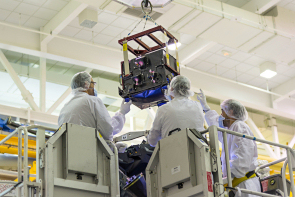 |
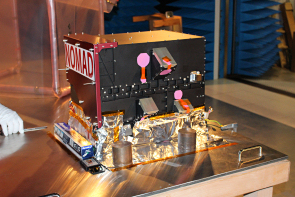 |
| NOMAD proto-flight model. Credit: ESA – B. Bethge |
NOMAD flight spare model. Credit: Belgian Institute for Space Aeronomy |
NOMAD is a spectrometer suite that can measure the spectrum of sunlight across a wide range of wavelengths (infrared, ultraviolet and visible). This broad coverage of the instrument enables the detection of the components of the Martian atmosphere, even in low concentrations. In addition to identifying the constituents of the Martian atmosphere, NOMAD also maps their locations.
The measurements are carried out in solar occultation, i.e. the instrument points toward the Sun when the Orbiter moves at the dark side of Mars, as well as in nadir mode, i.e. looking directly at the sunlight reflected from the surface and atmosphere of Mars. The inclination of the Orbiter has been chosen to optimise the science that can be done with the instrument suite.
 |
 |
| NOMAD structural-thermal model. Credit: Belgian Institute for Space Aeronomy |
Schematic representation of NOMAD. Credit: Belgian Institute for Space Aeronomy |
NOMAD covers the infrared (2.2-4.3 µm) and the ultraviolet-visible (0.2-0.65 µm) spectral regions, using the following three operational modes:
- The Solar Occultation mode (SO) operates by observing up to six small slices of the full spectral range each second. This allows observing several different target molecules that absorb at different wavelengths, whilst maximising the signal-to-noise ratio for each. During a solar occultation, which lasts about 5 minutes, 300 spectra at each wavelength can be taken providing a profile of the atmospheric composition from the top of the atmosphere down to almost the surface, depending on dust levels.
- The Limb, Nadir and Occultation mode (LNO) is sensitive to the lower light levels during nadir observations on Mars. The nadir coverage facilitates the study of the atmospheric composition in addition to examining Martian surface features, such as ice and frost. This measurement is carried out on average every 3 to 4 sols (a solar day on Mars, or sol, is 24 hours and 39 minutes) with varying local times across the planet.
- The Ultraviolet and Visible mode (UVIS) images the wavelength domain between 200 and 650 nm, every second, covering and providing more information about several interesting molecules, such as ozone, sulphuric acid and aerosols in the atmosphere.
| NOMAD participants |
| Principal Investigator Ann Carine Vandaele, Belgian Institute for Space Aeronomy, Belgium Co-Principal Investigators José Lopez Moreno, Instituto de Astrofísica de Andalucía, Spain Giancarlo Bellucci, Istituto Nazionale di Astrofisica, Italy Manish Patel, The Open University, United Kingdom |
| Participating countries Belgium, Spain, Italy, United Kingdom, United States of America, Canada |
| ESA contact |
| ExoMars instrument system engineer André Debus, Directorate of Science and Robotic Exploration, European Space Agency |
ACS - Atmospheric Chemistry Suite
The Atmospheric Chemistry Suite (ACS) is part of the instrument payload on the ExoMars Trace Gas Orbiter (TGO), launched in March 2016.
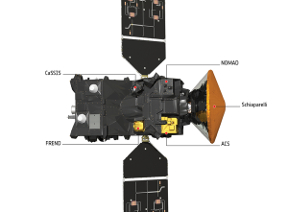 |
| ACS accommodation on the TGO. Credit: ESA / ATG medialab |
ACS is a set of three spectrometers that can measure the spectrum of sunlight across a wide range of wavelengths (near infrared, mid infrared, thermal infrared). This wavelength range enables the detection of water, methane and a variety of minor atmospheric constituents as well as the study of the structure of the atmosphere and its photochemistry.
The measurements are carried out in: solar occultation mode, i.e., the instrument points toward the Sun when the Martian atmosphere lies between the Sun and the Orbiter, at both sunrise and sunset; as well as in nadir mode, i.e., looking directly downward at the sunlight reflected from the surface of Mars; and also limb mode, i.e., looking towards the Martian horizon at the sunlight scattered from the atmosphere of Mars. The inclination of the TGO's orbital plane has been chosen to optimise the science that can be done with the instrument suite.
 |
| Atmospheric Chemistry Suite (ACS) modules. Credit: ESA/Roscosmos/ExoMars/ACS/IKI |
ACS comprises three spectrometers integrated into a single unit together with a central electronics box:
- ACS-NIR - an Echelle-Acousto-Optic Tuneable Filter (AOTF) spectrometer, which operates in nadir, limb and solar occultation modes, detecting infrared light in the wavelength range from 0.7 µm - 1.7 µm.
- ACS-MIR - an Echelle spectrometer, which operates in solar occultation mode, covering the range from 2.3 µm - 4.6 µm.
- ACS-TIR - a Fourier spectrometer with two channels, one covering 1.7 µm - 17 µm that operates in nadir and solar occultation modes, and another covering 1.7 µm - 4 µm (optimised for 3.3 µm) that operates in nadir mode.
ACS-NIR and ACS-MIR are designed to:
- derive vertical profiles (atmospheric density and temperature) of carbon dioxide (CO2), and known minor species such as methane (CH4), water (H2O) and carbon monoxide (CO) at the evening and morning terminators in the 10 km - 80 km altitude range;
- profile isotope ratios for HDO/H2O, 13CO2/CO2, CO18O/CO2, among others;
- search for undetected species such as acetylene (C2H2), ethylene (C2H4), ethane (C2H6), sulphur dioxide (SO2), hydroperoxyl (HO2), hydrogen peroxide (H2O2), formaldehyde (H2CO), hydrogen chloride (HCl) and carbonyl sulphide (OCS);
- obtain profiles of aerosols, distinguishing between dust and ice clouds;
- monitor ozone using dayglow O2 emission;
- perform a sensitive search for new hydroxide (OH), O2 and nitric oxide (NO) nightglow over a spectral range that is not covered by any other TGO spectrometer.
ACS-TIR is designed to:
- derive a vertical thermal profile of the atmosphere from the surface to an altitude of 50 - 55 km with a resolution of a few km, using the CO2/15 µm band over the full orbit in nadir mode;
- monitor atmospheric dust and condensation clouds;
- measure the surface temperature;
- map methane concentrations in the 3.3 µm band, on the day side, in nadir mode;
- detect methane and other minor atmosphere constituents using occultation mode.
- The separate components of ACS build on previous flight heritage. The MIR and NIR channels follow on from TIMM-2 (Phobos-Grunt), Rusalka (ISS) and SOIR (Venus Express). The TIR channel follows on from AOST (Phobos-Grunt) and PFS (Mars Express).
| ACS participants |
| Principal Investigator Oleg Korablev, Space Research Institute (IKI), Russian Academy of Sciences Deputy Principal Investigator Franck Montmessin, Laboratoire Atmosphères, Milieux, Observations Spatiales (LATMOS), France Project Manager A. Shakun, Space Research Institute (IKI), Russian Academy of Sciences |
| Participating countries Russia, France, Germany, Italy |
| ESA contact |
| ExoMars instrument system engineer Duncan Goulty, Directorate of Science and Robotic Exploration, European Space Agency |
CaSSIS - Colour and Stereo Surface Imaging System
The Colour and Stereo Surface Imaging System (CaSSIS) is part of the instrument payload on the ExoMars Trace Gas Orbiter (TGO), launched in March 2016.
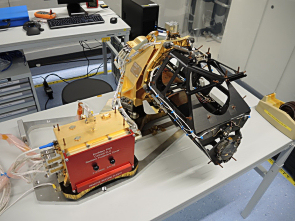 |
| CaSSIS flight model. Photo credit: University of Bern |
CaSSIS characterises sites that have been identified as potential sources of trace gases and investigates dynamic surface processes – for example, sublimation, erosional processes and volcanism – which may contribute to the atmospheric gas inventory. The instrument will also be used to certify potential landing sites by characterising local slopes, rocks and other possible hazards.
By acquiring colour and stereoscopic images of surface features, CaSSIS allows scientists to investigate whether specific types of geological processes might be associated with trace gas sources and sinks. The NOMAD and ACS instruments, also being carried by the orbiter, are used to identify sources of trace gases that could be evidence for biological or geological activity. The CaSSIS imaging system has a horizontal scale of about five metres per pixel; stereoscopic reconstruction enables a vertical resolution of about six metres.
CaSSIS is located on the Mars-surface-facing side of the orbiter. The orbiter science payload is primarily nadir pointing to keep the Martian surface in constant view. The orbiter rotates about an axis that maintains its solar panels oriented towards the Sun while avoiding solar illumination of its thermal radiators. CaSSIS can compensate for the spacecraft's yaw rotation using a drive mechanism, but during nominal stereoscopic imaging the orbiter pauses its yaw-rotation to maximise the paired-image accuracy. The rotation mechanism is able to turn the entire telescope system by 180° while its support structure remains fixed.
 |
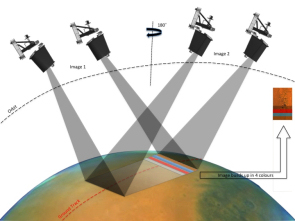 |
| Location of instruments on the ExoMars Trace Gas Orbiter. Credit: ESA/ATG medialab | CaSSIS stereo image acquisition principle. Credit: University of Bern |
This rotation system also enables the camera to acquire stereo images with only one telescope and focal plane assembly. A stereo image pair is acquired by first rotating the telescope to point 10° ahead of the spacecraft track to acquire the first image, then rotating it 180° to point 10° behind for the second stereo image. Optimal correlation of the stereo signals is ensured as there will be identical illumination conditions every time a stereo image pair is acquired.
The camera consists of a three-mirror off-axis telescope with an additional slightly powered folding mirror, which projects an image onto the focal plane. The instrument electronics unit is mounted separately on the spacecraft deck, next to the telescope. The imager covers an eight-kilometre-wide swathe of the planet's surface in four different wavelength ranges.
| CaSSIS imaging characteristics | |
| Telescope | Three-mirror anastigmat |
| Focal length | 880 mm |
| Aperture | 135 mm |
| Angular scale | 5 μrad / pixel |
| Telescope field of view | 1.34° × 0.88° |
| Filter wavelengths (bandwidths) | Pan 650 nm (250 nm) IR 950 nm (150 nm) NIR 850 nm (120 nm) Blue-Green 475 nm (150 nm) |
| CaSSIS participants | |
| Principal Investigator Nicolas Thomas, University of Bern, Switzerland |
|
| Co-Principal Investigator Gabriele Cremonese, Astronomical Observatory, Padova, Italy |
|
| Participating countries Switzerland, Italy, Poland |
|
| ESA contact | |
| ExoMars instrument system engineer Duncan Goulty, Directorate of Science and Robotic Exploration, European Space Agency |
|
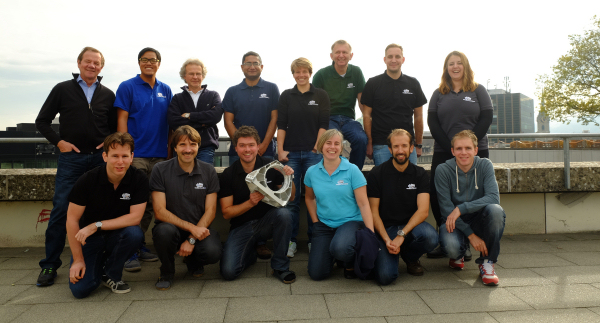 |
| CaSSIS Principal Investigator Nicolas Thomas (third from right, back row) with the CaSSIS team from the University of Bern. Credit: University of Bern |
FREND - Fine Resolution Epithermal Neutron Detector
The Fine Resolution Epithermal Neutron Detector (FREND) is part of the instrument payload on the ExoMars Trace Gas Orbiter (TGO), launched in March 2016.
 |
| The FREND flight spare model. Credit: ESA/Roscosmos/FREND/IKI |
FREND is a neutron detector with a collimation module that significantly narrows the field of view of the instrument, thus allowing the creation of higher-resolution maps of hydrogen-abundant regions on Mars.
FREND measures the flux of neutrons from the Martian surface; these are produced by the continuous cosmic ray bombardment that interacts with the first few metres of rock and regolith. The cosmic rays are sufficiently energetic to break apart atoms in the top one or two metres of the planetary surface, releasing high-energy neutrons that are then slowed down and absorbed by the nuclei of elements in the surrounding material. Not all the neutrons are captured – many escape, creating a leakage flux of neutrons that the FREND instrument can observe.
The distribution of neutron velocities, which depends upon how much they were slowed down before escaping, can reveal much about the surface material since it depends on the composition of that material – primarily on its hydrogen content. Even small quantities of hydrogen are known to cause a measurable change in the neutron velocity distribution from the surface of celestial bodies with thin or no atmospheres. This measured hydrogen content can be related to the presence of water.
 |
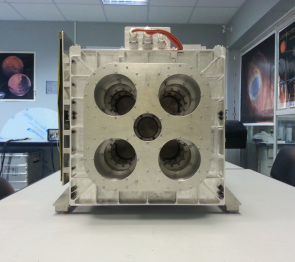 |
| Location of instruments on the ExoMars Trace Gas Orbiter. Credit: ESA/ATG medialab | The FREND flight spare model. Credit: ESA/Roscosmos/FREND/IKI |
Epithermal neutrons with energies in the 0.4 eV - 500 keV range are detected by 3He counters, while neutrons with energies from 0.5 MeV - 10 MeV are detected using a stylbene scintillator crystal.
FREND also contains a dosimeter module to monitor the local radiation environment. This helps to increase the accuracy of the neutron measurements by providing information about other radiation fluctuations (including space weather driven by the Sun) that can have an impact on the signals from the 3He and stylbene detectors.
FREND is designed to:
- perform high spatial resolution mapping of epithermal and fast neutron fluxes from the Martian surface;
- monitor neutrons and charged particle fluxes over broad energy ranges during periods of quiet Sun and during solar particle events;
- provide maps of hydrogen concentration in the Martian soil at high spatial resolution;
- allow comparison of orbital and ground data as measured by FREND on TGO, the Dynamic Albedo of Neutrons (DAN) instrument on the Mars Science Laboratory (MSL, also known as Curiosity), and the Adron instrument on the ExoMars 2022 Rover;
- search for temporal changes in neutron fluxes related to the seasonal Martian water cycle and galactic cosmic ray variations.
FREND builds on previous and current flight heritage, most notably the High Energy Neutron Detector (HEND) on Mars Odyssey; the Lunar Exploration Neutron Detector (LEND) on the Lunar Reconnaissance Orbiter; the Mercury Gamma and Neutron Spectrometer on BepiColombo; and DAN on MSL.
| FREND participants |
| Principal Investigator Igor Mitrofanov, Space Research Institute (IKI), Russian Academy of Sciences Instrument Manager Alexey Malakhov, Space Research Institute (IKI), Russian Academy of Sciences |
| Participating countries Russia, United States of America |
| ESA contact |
| ExoMars instrument system engineer Duncan Goulty, Directorate of Science and Robotic Exploration, European Space Agency |
